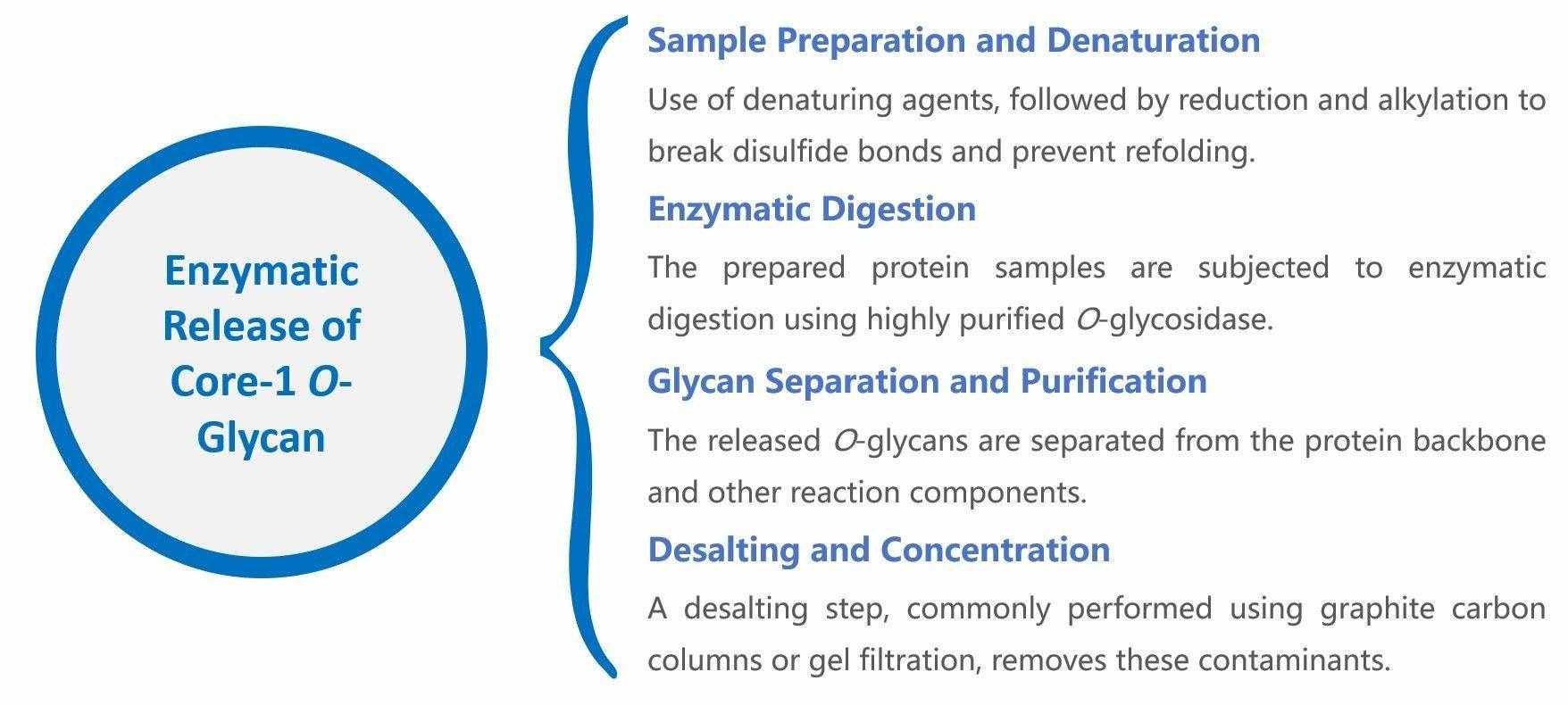



In the field of Glycan Release, CD BioGlyco continuously updates the Enzymatic Release technology to ensure efficient and accurate glycan release services for clients. We have the confidence to be your best research assistant in the field of glycan release.
O-Glycosylation is a common post-translational modification of glycoproteins. Fundamentally different from N-glycosylation, the consensus amino acid sequence typical of O-glycosylation has not been clearly defined. Tyrosine (Tyr), hydroxylysine (hydroxy-Lys), or hydroxyproline (hydroxy-Pro) may be the peptide sites for O-linked glycosylation. Mucin-type glycans are the most common O-glycans and are involved in several important biological events, including intercellular communication in higher eukaryotes and adhesion between bacteria and host cells. Eight mucin-type core structures have been discovered. Core 1, also known as T antigen, is one of the most abundant core O-glycan structures. It links galactosyl β1,3-N-acetylgalactosamine (N-GalNAc) via an alpha bond to serine (Ser) or threonine (Thr) residue. Core 1 is also a precursor to more complex O-glycans such as extended core 1 and core 2 structures.
 Fig.1 O-Glycan structures core 1-8. (Helms & Brodbelt, 2024)
In the field of Glycan Release, CD BioGlyco continuously updates the Enzymatic Release technology to ensure efficient and accurate glycan release services for clients. We have the confidence to be your best research assistant in the field of glycan release.
Fig.1 O-Glycan structures core 1-8. (Helms & Brodbelt, 2024)
In the field of Glycan Release, CD BioGlyco continuously updates the Enzymatic Release technology to ensure efficient and accurate glycan release services for clients. We have the confidence to be your best research assistant in the field of glycan release.
O-Glycans are found on erythropoietin (EPO) or interleukin 2 (IL-2) and other human proteins such as immunoglobulin A (IgA) or mucin-1 (MUC1) also contain O-glycans sugar clusters. Since specific O-glycans are more abundant in tumors, it has been proposed to use peptides containing specific O-glycan structures as anticancer vaccines to elicit immune responses against cancer cell epitopes. O-Linked glycans attached to membrane glycoproteins or cell surface glycolipids are also involved in hematopoiesis and inflammatory responses. Core 1-derived O-glycans are involved in many important biological processes such as leukocyte lymphocyte homing, inflammation, and animal development.
CD BioGlyco uses a combination of advanced technologies to ensure precise and efficient enzymatic release of core-1 O-glycans. The core of our approach is the rational use of highly specific glycosidases, optimized buffer systems and reaction conditions, advanced protein denaturation and reduction techniques, and advanced reaction monitoring equipment.
O-Glycans are essential for physiological and pathological processes. A reliable method must be identified to better separate O-glycans from proteins before analysis. Conventional methods include enzymatic release methods and Chemical Release methods. At CD BioGlyco, we have developed an advanced glycan release platform. We provide our clients with efficient and accurate release services of core 1 O-glycans from native glycoproteins. We successfully cleave core 1 O-glycans and maintain protein structure by specific O-glycosidases. In addition, we provide clients with rapid and sensitive O-glycan quantification and characterization services.
 Fig.2 The process of enzymatic release of core-1 O-glycan. (CD BioGlyco)
Fig.2 The process of enzymatic release of core-1 O-glycan. (CD BioGlyco)
Client-supplied glycoproteins, cell lysates, or biological fluids are processed. This typically involves heat treatment and the use of denaturants, followed by reduction and alkylation to disrupt disulfide bonds and prevent refolding.
After denaturation, the sample is enzymatically digested using a highly purified O-glycosidase under optimized conditions of pH, temperature, and incubation time to ensure selective release of glycosylates and minimize nonspecific degradation. The enzyme specifically targets the O-glycosidic bonds connecting core-1 O-glycans to serine or threonine residues in proteins.
Following enzymatic digestion, the released O-glycans are separated from the protein backbone and other reaction components using techniques such as size exclusion chromatography (SEC), solid phase extraction (SPE), or precipitation.
Graphene carbon columns or gel filtration are used to remove salts and other small molecules that interfere with downstream analysis and concentrate the glycans to the desired concentration for optimal detection and characterization.
Techniques such as sodium dodecyl sulfate-polyacrylamide gel electrophoresis (SDS-PAGE), mass spectrometry (MS), and various chromatographic methods are used to ensure the high quality and integrity of the released core-1 O-glycans.

Journal: International Journal of Molecular Sciences
IF: 4.9
Published: 2022
Results: This article discusses the critical role of core 1-derived O-glycans in adult mice. Global loss of these glycans, due to the deletion of Cosmc (an enzyme essential for their synthesis), leads to high mortality, severe weight loss in various organs, leukocytopenia, thrombocytopenia, acute pancreatitis, adipose tissue atrophy, spontaneous gastric ulcers, and severe renal dysfunction. The research, conducted using inducible CAGCre-ERTM/Cosmc-knockout (iCAG-Cos) mice, reveals that these O-glycans are crucial for maintaining homeostasis in adult mice.
CD BioGlyco is your premier partner for the enzymatic release of core-1 O-glycans, offering a precise, reliable, and highly efficient solution for your glycomics research needs. Please feel free to contact us to discuss your specific project needs.
References
